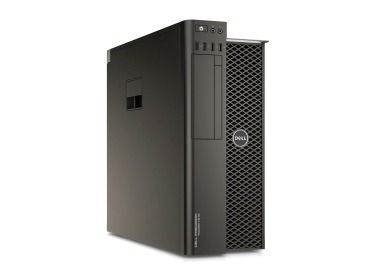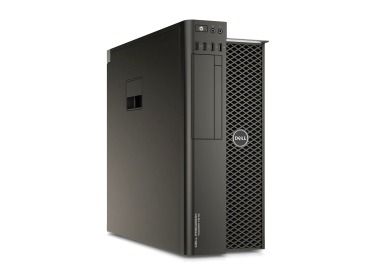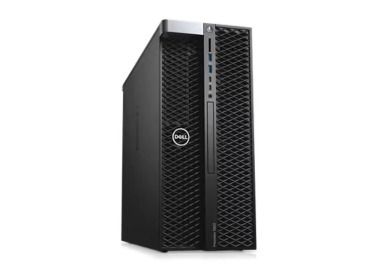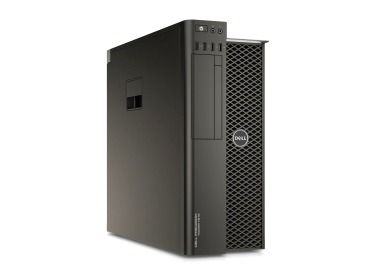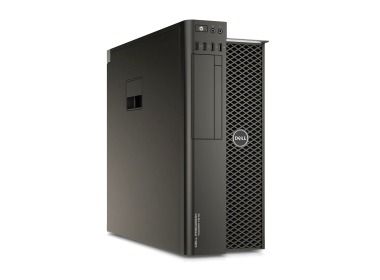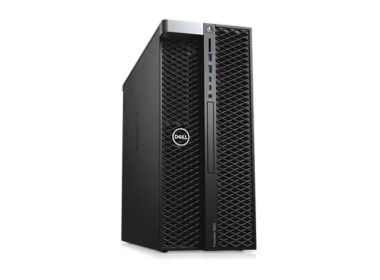- Workstation Dell Precision T7810 2x3.5" with 1x E5-2667v3, 32GB RAM, 1x 480GB SSD SATA 2.5", 1x Quadro M4000, 1x PSU1x Intel Xeon E5-2667 v3 8-core 3.2GHz 20MB 135W SR203 processor 2x RAM 16GB 2133MHz DDR4 RDIMM 1x 480GB SSD SATA 2.5" hard drive 2x 2.5"/3.5" d...Calculating delivery time...In stock 1Warranty 36 monthsPLN 2,825.00 PLN 2,296.75
- Workstation Dell Precision T7810 2x3.5" with 2x E5-2640v3, 32GB RAM, 1x 960GB SSD SATA 2.5", 1x Quadro K4200, 1xPSU2x Intel Xeon E5-2640 v3 8-core 2.6GHz 20MB 90W SR205 processor 2x RAM 16GB 2133MHz DDR4 RDIMM 1x Hard drive 960GB SSD SATA 2.5" 2x 2.5"/3.5" dr...Calculating delivery time...In stock 1Warranty 36 monthsPLN 3,025.00 PLN 2,459.35
- Workstation Dell Precision T7810 2x3.5" with 2x E5-2667v4, 32GB RAM, 1x 960GB SSD SATA 2.5", 1x Quadro K4200, 1x PSU2x Intel Xeon E5-2667 v4 8-core 3.2GHz 25MB 135W SR2P5 processor 2x RAM 16GB 2133MHz DDR4 RDIMM 1x Hard drive 960GB SSD SATA 2.5" 2x 2.5"/3.5" d...Calculating delivery time...In stock 1Warranty 36 monthsPLN 3,400.00 PLN 2,764.23
- Workstation Dell Precision T5820 4x3.5" with 1x W-2133, 64GB RAM, 2x 480GB SSD SATA 2.5", 1x PSU,1x Intel Xeon W-2133 6-Core 3.6GHz 8.25MB 140W SR3LL processor 4x RAM 16GB DDR4 2666MHz RDIMM 2x 480GB SSD SATA 2.5" hard drive 2x 960GB SSD NVMe 2.5"...Calculating delivery time...In stock 1Warranty 36 monthsPLN 3,504.27 PLN 2,849.00
- Workstation Dell Precision T7810 2x3.5" with 2x E5-2690v4, 64GB RAM, 1x 960GB SSD SATA 2.5", 1x Quadro M4000, 1x PSU2x Intel Xeon E5-2690 v4 14-core 2.6GHz 35MB 135W SR2N2 processor 4x RAM 16GB 2133MHz DDR4 RDIMM 1x Hard drive 960GB SSD SATA 2.5" 2x 2.5"/3.5" ...Calculating delivery time...In stock 1Warranty 36 monthsPLN 3,624.99 PLN 2,947.15
- Workstation Dell Precision T7810 2x3.5" with 2x E5-2667v3, 64GB RAM, 2x 480GB SSD SATA 2.5", 1x Quadro P4000, 1x PSU2x Intel Xeon E5-2667 v3 8-core 3.2GHz 20MB 135W SR203 processor 4x RAM 16GB 2133MHz DDR4 RDIMM 2x 480GB SSD SATA 2.5" hard drive 2x 2.5"/3.5" d...Calculating delivery time...In stock 1Warranty 36 monthsPLN 4,375.00 PLN 3,556.91
- Workstation Dell Precision R7910 8x2.5" with 2xE5-2687Wv4, 64GB RAM, H730P, 2x 480GB SSD SATA 2.5", 4x1GbE, 1xQuadro K2200, 2xPSU, Rails, iDRAC 8 Enterprise2x Intel Xeon E5-2687W v4 12-core 3GHz 30MB 160W SR2NA processor 2x RAM 16GB 2133MHz DDR4 RDIMM 2x 480GB SSD SATA 2.5" hard drive 8x 2.5" drive tray ...Calculating delivery time...In stock 1Warranty 36 monthsPLN 5,625.00 PLN 4,573.17
- Workstation Dell Precision T5820 4x3.5" with 1x W-2133, 64GB RAM, 1x 960GB SSD SATA 2.5", RTX 4070 Super, 1x PSU, DVD-RW1x Intel Xeon W-2133 6-Core 3.6GHz 8.25MB 140W SR3LL processor 4x RAM 16GB DDR4 2666MHz RDIMM 1x Hard drive 960GB SSD SATA 2.5" 1x Nvidia RTX 4070 SUPER 1...Calculating delivery time...In stock 1Warranty 36 monthsPLN 5,775.00 PLN 4,695.12
- Workstation Dell Precision R7910 8x2.5" with 2xE5-2667v4, 64GB RAM, H730P, 2x480GB SSD SATA 2.5", 1xQuadro M2000, 2xPSU, rails, iDRAC 8 Enterprise, Windows 11 Pro2x Intel Xeon E5-2667 v4 8-core 3.2GHz 25MB 135W SR2P5 processor 4x RAM 16GB 2133MHz DDR4 RDIMM 2x 480GB SSD SATA 2.5" hard drive 8x 2.5" drive tray ...Calculating delivery time...In stock 1Warranty 36 monthsPLN 6,000.00 PLN 4,878.05
- Workstation Dell Precision T5820 4x3.5" z 1x W-2133, 64GB RAM, 2x 480GB SSD SATA 2.5", RTX 4070 Super, 1x PSU, DVD-RW1x Intel Xeon W-2133 6-Core 3.6GHz 8.25MB 140W SR3LL processor 4x RAM 16GB DDR4 2666MHz RDIMM 2x 480GB SSD SATA 2.5" hard drive 1x Nvidia RTX 4070 SUPER 1...Calculating delivery time...In stock 1Warranty 36 monthsPLN 6,025.00 PLN 4,898.37
- Workstation Dell Precision T5820 4x3.5" with 1x W-2145, 64GB RAM, 1x 960GB SSD SATA 2.5", RTX 4070 Super, 1x PSU, DVD-RW1x Intel Xeon W-2145 8-core 3.7GHz 11MB 140W SR3LQ processor 4x RAM 16GB DDR4 2666MHz RDIMM 1x Hard drive 960GB SSD SATA 2.5" 1x Nvidia RTX 4070 SUPER 12G...Calculating delivery time...In stock 1Warranty 36 monthsPLN 6,500.00 PLN 5,284.55
- Workstation Dell Precision R7920 8x3.5" with 2x Gold 5120, 96GB RAM, H730P, 2x 480GB SSD SATA 2.5", 4x1GbE, 1xQuadro K620, 2xPSU, Rails, iDRAC 9 Enterprise2x Intel Xeon Gold 5120 14-core 2.2GHz 19.25MB 105W SR3GD processor 6x RAM 16GB 2400MHz DDR4 RDIMM 2x 480GB SSD SATA 2.5" hard drive 8x 3.5" drive tr...Calculating delivery time...In stock 1Warranty 36 monthsPLN 6,650.00 PLN 5,406.50
- Workstation Dell Precision R7920 8x3.5" with 2x Gold 5118, 64GB RAM, H730P, 2x 480GB SSD SATA 2.5", 4x1GbE, 1x Pro WX4100, 2xPSU, Rails, iDRAC 9 Enterprise2x Intel Xeon Gold 5118 12-core 2.3GHz 16.5MB 105W SR3GF processor 4x RAM 16GB 2400MHz DDR4 RDIMM 2x 480GB SSD SATA 2.5" hard drive 8x 3.5" drive tra...Calculating delivery time...In stock 1Warranty 36 monthsPLN 6,675.00 PLN 5,426.83
- Workstation Dell Precision T7920 4x3.5" with 2x Gold 6154, 16GB RAM, 1x 960GB SSD SATA 2.5", 1x Quadro P2000, 1x PSU2x Intel Xeon Gold 6154 18-core 3GHz 24.75MB 200W SR3J5 processor 2x RAM 8GB 2666MHz DDR4 RDIMM 1x Hard drive 960GB SSD SATA 2.5" 4x 2.5"/3.5" d...Calculating delivery time...In stock 1Warranty 36 monthsPLN 7,175.00 PLN 5,833.33
- Workstation Dell Precision T5820 4x3.5" with 1x W-2255, 64GB RAM, 1x 480GB SSD SATA 2.5", 1x Quadro P5000, 1x PSU1x Intel Xeon W-2255 10-core 3.7GHz 19.25MB 165W SRGV8 processor 4x RAM 16GB 2933MHz RDIMM DDR4 1x Hard drive 960GB SSD SATA 2.5" 1x Nvidia Quadro P5000 1...Calculating delivery time...In stock 1Warranty 36 monthsPLN 7,300.00 PLN 5,934.96
- Workstation Dell Precision R7920 8x3.5" with 2x Silver 4208, 128GB RAM, H730P, 2x 480GB SSD SATA 2.5", 1x Quadro K620, 2xPSU, Rails, iDRAC 9 Enterprise2x Intel Xeon Silver 4208 8-core 2.1GHz 11MB 85W SRFBM processor 4x RAM 32GB 2400MHz DDR4 RDIMM 2x 480GB SSD SATA 2.5" hard drive 8x 3.5" drive tray ...Calculating delivery time...In stock 1Warranty 36 monthsPLN 7,725.00 PLN 6,280.49
- Workstation Dell Precision T7820 4x3.5" with 2x Gold 5122, 32GB RAM, 1x 960GB SSD SATA 2.5", 1x Quadro P6000, 1x PSU2x Intel Xeon Gold 5122 4-core 3.6GHz 16.5MB 105W SR3AT processor 2x RAM 16GB DDR4 2666MHz RDIMM 1x Hard drive 960GB SSD SATA 2.5" 4x 2.5"/3.5" ...Calculating delivery time...In stock 1Warranty 36 monthsPLN 11,400.00 PLN 9,268.29
Good rendering starts with good hardware. Whether you're working in Blender, 3ds Max, Maya, Houdini, or Unreal Engine, a 3D rendering workstation must withstand not only the final export, but the entire process: lighting setup, baking, particle simulations, previews, and tests. At Hardware Direct, you'll find Dell Precision class computers – with Quadro, RTX, Xeons, Threadrippers, and ECC memory – designed for the demanding workloads typical of CGI, animation, and visualization environments. These are off-lease models, thoroughly tested and ready to use right away – for a fraction of the price of new hardware.
You Can't "Render Everything on a Laptop." See What a 3D Rendering Workstation with 36 Cores and an RTX Can Do
For those working on complex projects – whether it's 4K commercial films or realistic product animations – rendering time is a real cost. The Dell Precision T7820 with 2x Xeon Gold 6154 offers a staggering 36 physical cores, which, combined with a Quadro P6000 or RTX 4070 Super, can significantly reduce export times in Redshift, V-Ray, or Cycles X. These configurations let you easily split rendering tasks between the CPU and GPU, simultaneously handle a viewport preview, and simulate smoke, water, or fabrics in the background. Performance? Up to 16 TFLOPS for RTX graphics cards, plus 128 GB of RAM and fast SSD or RAID storage with an H730P controller. This is hardware that can reduce render time from 3 hours to 40 minutes – without overheating or crashing.
Cycles, V-Ray, Redshift, Octane – If You Use These Engines, Your Workstation Should Be Designed for Them
Each rendering engine has its preferences. OctaneRender and Redshift leverage CUDA and RT Cores, so they need cards like the RTX 4070 Super or RTX 6000 that support OptiX and DLSS. Cycles X in Blender uses both CUDA and OptiX – the newer the card, the faster the sampling and less noise in the final render. V-Ray, on the other hand, can still effectively use the CPU with the right configuration. That's why it's worth investing in workstations that combine CPU power (min. 16 cores) with Quadro/RTX-class graphics cards and over 64 GB of RAM. An example? The Dell T5820 with an RTX 4070 Super and a Xeon W-2145 is a ready-to-go setup for GPU-heavy renders, but with a power buffer for CPU-based plugins and simulations.
Larger Scene? More Textures? With This Amount of RAM and NVMe, You Don't Have to Compromise!
Working with large 3D scenes isn't just about the graphics card. It's primarily about RAM – because every 4K texture, every displacement, every cloth or smoke simulation cache first goes into system memory. That's why workstations with 64 GB or 128 GB of DDR4 ECC RAM are essential for production where a scene exceeds 5 million polygons or 100 objects with separate materials. Add to that fast NVMe SSDs (e.g., 960 GB or 1 TB) – which allow for smooth work with large project files, HDRI materials, and cache files. Hardware Direct offers setups with RAIDs based on Dell H730P controllers, giving you both performance and data security. And if something fails – the drives are hot-swappable, backup comes from a copy, and your project keeps moving.
3D Rendering Workstations – You Don't Have to Buy New Hardware for 20,000 to Render Like a Pro
Brand new 3D rendering hardware can cost upwards of 30,000-40,000 PLN. But the truth is, you can achieve the same effect – the same rendering time, the same viewport FPS, and the same EXR export – on an off-lease workstation like the Dell Precision T7820 or R7920, if you choose wisely. For example? The Dell T5820 with an RTX 4070 Super here costs around 4,300 PLN gross – less than a single software license, yet it delivers enough performance for real-time 3D engine work. Our setups are ready to power on right out of the box, with a 36-month warranty, tested under load, and protected against errors. If you're tired of waiting but don't want to overspend – this is where performance meets practicality.
Not Sure What's Better: RTX 4070 Super or Quadro P6000? We'll Help You Choose Based on Your Tools and Engine
Blender, Maya, Houdini, 3ds Max, Unreal Engine – each of these programs utilizes different hardware components. So, instead of guessing, it's better to ask. At Hardware Direct, we'll advise you on which processor, graphics card, and memory configuration best suits your pipeline. Tell us what you work on – we'll tell you what will be faster, what will be more stable, and what's worth investing in. Every workstation is checked, and its configuration is selected for specific workloads: rendering, simulations, compositing, AI denoise, preview. Because in rendering, it's not just about it working. It's about it always working, without exception.








